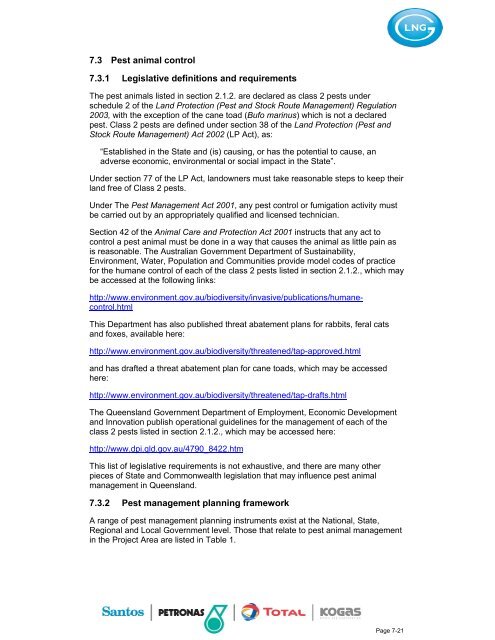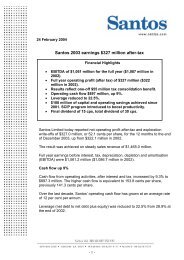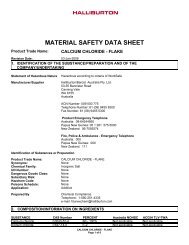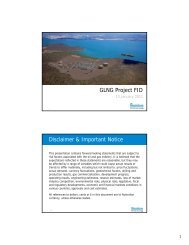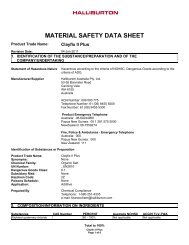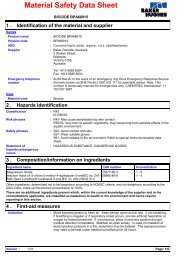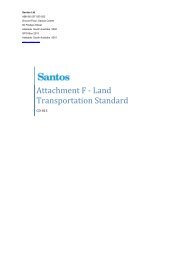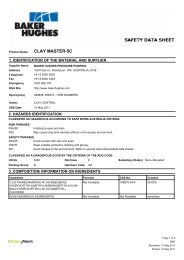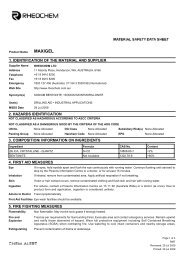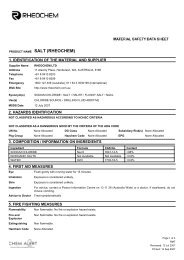Appendix B – Pest and Weed Management Plan (5 MB) - Santos
Appendix B – Pest and Weed Management Plan (5 MB) - Santos
Appendix B – Pest and Weed Management Plan (5 MB) - Santos
Create successful ePaper yourself
Turn your PDF publications into a flip-book with our unique Google optimized e-Paper software.
7.3 <strong>Pest</strong> animal control<br />
7.3.1 Legislative definitions <strong>and</strong> requirements<br />
The pest animals listed in section 2.1.2. are declared as class 2 pests under<br />
schedule 2 of the L<strong>and</strong> Protection (<strong>Pest</strong> <strong>and</strong> Stock Route <strong>Management</strong>) Regulation<br />
2003, with the exception of the cane toad (Bufo marinus) which is not a declared<br />
pest. Class 2 pests are defined under section 38 of the L<strong>and</strong> Protection (<strong>Pest</strong> <strong>and</strong><br />
Stock Route <strong>Management</strong>) Act 2002 (LP Act), as:<br />
“Established in the State <strong>and</strong> (is) causing, or has the potential to cause, an<br />
adverse economic, environmental or social impact in the State”.<br />
Under section 77 of the LP Act, l<strong>and</strong>owners must take reasonable steps to keep their<br />
l<strong>and</strong> free of Class 2 pests.<br />
Under The <strong>Pest</strong> <strong>Management</strong> Act 2001, any pest control or fumigation activity must<br />
be carried out by an appropriately qualified <strong>and</strong> licensed technician.<br />
Section 42 of the Animal Care <strong>and</strong> Protection Act 2001 instructs that any act to<br />
control a pest animal must be done in a way that causes the animal as little pain as<br />
is reasonable. The Australian Government Department of Sustainability,<br />
Environment, Water, Population <strong>and</strong> Communities provide model codes of practice<br />
for the humane control of each of the class 2 pests listed in section 2.1.2., which may<br />
be accessed at the following links:<br />
http://www.environment.gov.au/biodiversity/invasive/publications/humanecontrol.html<br />
This Department has also published threat abatement plans for rabbits, feral cats<br />
<strong>and</strong> foxes, available here:<br />
http://www.environment.gov.au/biodiversity/threatened/tap-approved.html<br />
<strong>and</strong> has drafted a threat abatement plan for cane toads, which may be accessed<br />
here:<br />
http://www.environment.gov.au/biodiversity/threatened/tap-drafts.html<br />
The Queensl<strong>and</strong> Government Department of Employment, Economic Development<br />
<strong>and</strong> Innovation publish operational guidelines for the management of each of the<br />
class 2 pests listed in section 2.1.2., which may be accessed here:<br />
http://www.dpi.qld.gov.au/4790_8422.htm<br />
This list of legislative requirements is not exhaustive, <strong>and</strong> there are many other<br />
pieces of State <strong>and</strong> Commonwealth legislation that may influence pest animal<br />
management in Queensl<strong>and</strong>.<br />
7.3.2 <strong>Pest</strong> management planning framework<br />
A range of pest management planning instruments exist at the National, State,<br />
Regional <strong>and</strong> Local Government level. Those that relate to pest animal management<br />
in the Project Area are listed in Table 1.<br />
Page 7-21


